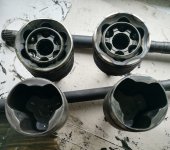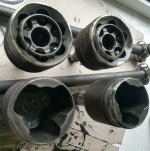Hello, I have recently purchased a Panda 2011 1.2 Active which has been an eventful experience!! Just as I sort one problem out another seems to raise it's head!
Anyway, I have read that the driveshafts can be a bit stubborn to remove from the diff/gearbox end, probably requiring a pry bar. The Haynes manual recommends removing the 2 bolts holding the hub to the bottom of the suspension strut and also the tie rod ball joint. Then pivot the hub away to allow the driveshaft to be removed from the hub end. I have also seen a gentleman on You Tube (admittedly this was on a punto) just undo the pinch bolt on the lower ball joint and seperate the hub from the lower control arm (think it's called that). This also seemed to allow enough room for the driveshaft to be removed from the hub. Just wondering if any folk have undertaken this job and their preferred method. Thanks very much. Richard.
Anyway, I have read that the driveshafts can be a bit stubborn to remove from the diff/gearbox end, probably requiring a pry bar. The Haynes manual recommends removing the 2 bolts holding the hub to the bottom of the suspension strut and also the tie rod ball joint. Then pivot the hub away to allow the driveshaft to be removed from the hub end. I have also seen a gentleman on You Tube (admittedly this was on a punto) just undo the pinch bolt on the lower ball joint and seperate the hub from the lower control arm (think it's called that). This also seemed to allow enough room for the driveshaft to be removed from the hub. Just wondering if any folk have undertaken this job and their preferred method. Thanks very much. Richard.
- Model
- 1.2 active
- Year
- 2011
- Mileage
- 115000



